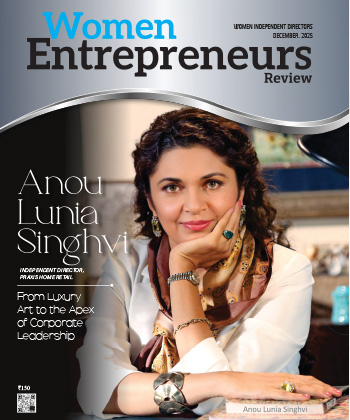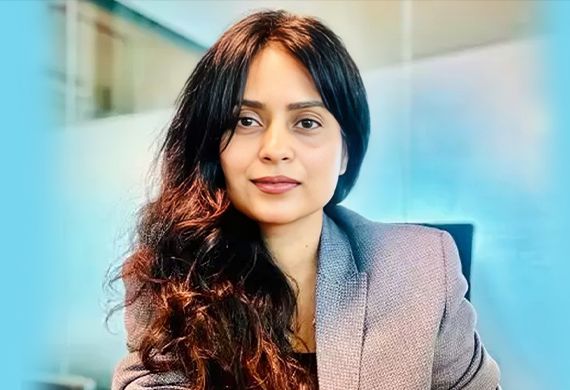
Women Leaders' Guide to Navigating the Dynamic Digital Landscape
By: Anmol Jalota, Head of Digital Enabling Functions, Signify Greater India
Anmol Reen Jalota is a seasoned IT leader with over 22 years of experience in digital strategy, agile transformation, and large-scale program delivery. She excels in building high-performing teams, driving innovation, and leading inclusive, business-aligned digital transformation across global functions.
In an insightful interaction with Women Entrepreneurs Review Magazine, Anmol shares her insights on emerging digital disruptions in electronics manufacturing, inclusive leadership in digital CoEs, and the unique opportunities and challenges women leaders face in driving agile transformations at scale.
As the digital landscape evolves rapidly, which emerging digital trends are creating the biggest disruption, particularly for women leaders driving these transformations?
As we know, the digital disruption in our space is being driven by AI-enabled lighting, IoT integration, connected ecosystems, and the shift from product-centric to solution-centric business models. What’s especially transformative is how data and connectivity are reconfiguring entire supply chains, customer interactions, and energy footprints.
For women leaders like me, these trends aren’t just technological; instead, they’re redefining the leadership toolkit. The emphasis is shifting from control to collaboration, from static expertise to adaptive learning, and from hierarchy to horizontal teams; the fields where many women thrive, driving innovation with empathy, guiding sustainable strategies, and leading with agility.
That said, while digitalization itself is largely gender-neutral in terms of opportunity, navigating old perceptions in leadership rooms still requires a certain clarity of voice and conviction, yet the transformation is occurring, with or without permission.
How can digital CoEs be designed to not only foster innovation but also inclusive leadership cultures that amplify women’s voices in traditionally male-dominated tech environments?
In today’s digital economy, the tech industry continues to lead innovation and economic growth. Unsurprisingly, digital Center of Excellence (CoEs) can be powerful catalysts for inclusive leadership when designed intentionally, with intentionality being the key.
A CoE should be more than a technical hub, but a cultural blueprint as well. At Signify, we’ve seen that innovation scales faster when your digital teams reflect the diversity of the world we’re designing for. That doesn’t happen by chance; it’s built into how you select leaders, how you reward collaboration, and how you define success- not the kind of inclusion that is a “theme”, nor a performative one, but an actual filter for better decision-making.
True inclusivity needs psychological safety, real mentorship (not just token programs), and leadership that recognizes performance without bias. Our approach includes comprehensive strategy development initiatives to integrate diverse perspectives, sharing best practices across teams and geographies, providing robust training and mentorship to build future-ready skills regardless of background, and fostering people-centric cultures where all voices are heard and respected- all of which I believe is essential to foster innovation in an equitable environment.
Clearly, we don’t need to “amplify” women’s voices—we’re already speaking. The job is to make sure we’re not speaking into a void.
What unique challenges and opportunities do women leaders face in championing cross-functional agile teams for large-scale digital deliveries?
Agile transformation promises speed, adaptability, and empowerment—but sustaining it at scale demands more than frameworks. For women leaders, the agile environment presents a paradox. On the one hand, it offers a natural fit: agile thrives on collaboration, active listening, and iterative learning—qualities many women leaders bring to the table and have honed, often out of necessity.
But there are also structural realities that remain unchanged. Flattened hierarchies can obscure contributions, and quick pivots can magnify invisible labor, particularly in roles involving stakeholder alignment or people dynamics.
The opportunity lies in deliberately shaping the agile culture, not just deploying the methodology. This means holding space for different leadership voices, building cross-functional trust from the start, and ensuring that performance in agile teams is measured not only by delivery metrics, but by how well they’ve fostered resilience, clarity, and shared ownership.
I’ve found that when women lead with both strategic rigor and emotional intelligence—balancing delivery pressure with team health—they often set a precedent for what agility actually looks like in practice.
How can women leaders leverage data insights to create more empathetic, people-centric digital strategies that balance tech with human impact?
Data is as much about dashboards as it is about decisions. The power of analytics lies in how you frame the questions and what you choose to optimize for.
As a leader, I’ve learned that technical fluency must go hand-in-hand with human understanding. Whether we’re designing lighting for cities, hospitals, or homes, we ask: How does this make someone’s life better? That’s where empathy enters, not as sentiment, but as strategy.
Women leaders often bring that lens naturally, but it’s less about gender and more about mindset. The challenge is to avoid over-indexing on efficiency at the cost of meaning. The real transformation happens when you use data to build systems that listen, adapt, and serve, rather than simply scale.
At Signify, we have seen firsthand how this balance of innovation and empathy can create a tangible impact. For instance, our smart lighting solutions go beyond traditional efficiency metrics; they adapt to human behaviour, enhance well-being, and support sustainability goals. Whether it’s circadian lighting in healthcare or connected lighting in smart cities, data helps us build systems that respond to real human needs, rather than focusing solely on technical requirements., a feat which cannot have been achieved without women leaders.
LAST WORD: Message For Women Leaders in the Digital Space
Leadership in digital transformation rarely comes with clear lines or easy choices. You’ll be navigating ambiguity, friction, and legacy structures—often all at once. My message to women leaders is this: you don’t need to be flawless to be effective. You don’t need to mirror the style you see around you to make an impact. Lead with clarity, stay grounded in your principles, and don’t wait for permission to take up space.
Global programs will test your resilience, but they also present a unique vantage point—you’ll see patterns others miss, and connections others overlook. Use that, ask better questions, and align people across silos. Learn fast but lead with patience.
Above all, trust that your perspective, especially when it diverges; it’s not a liability, it’s your value. The most effective leaders I know are grounded in their values but unafraid to challenge legacy norms.
Most Viewed
- 1 Women's Health Startup HerMD Closing Doors Amid Industry Challenges
- 2 5 Famous Women in Indian Armed Forces
- 3 Saudi Women No longer Require Male Permission for Clothing Choices, says Prince MbS
- 4 Kolkata Medtech Startup Innovodigm Raises Rs 5.5 Crore Seed Funding Led by IAN Group
- 5 Yamunanagar's Kashish Kalra Honoured after Securing 111th Rank in UPSC Civil Services Exam
- 6 Madurai Appoints Its First Woman Corporation Head
- 7 IAS Vijayalakshmi Bidari Appointed as the new Nagpur Divisional Commissioner
- 8 American Entrepreneur Lucy Guo Overtakes T Swift to become Youngest Female Billionaire
- 9 ICC Women's World Cup 2025 Trophy Showcased at Indore's Holkar Stadium
- 10 Aparna Saxena's Beauty Venture AntiNorm Launches in India
- 11 Vidya Nataraj Co-Founded BlueStone Jewellery & Lifestyle files IPO
- 12 5 Women Freedom Fighters of India
- 13 Dr. G Krishnapriya appointed as CEO for Trichy
- 14 M3M & Sirona Partner to Introduce Menstrual Hygiene Vending Machines in 15 Locations
- 15 Punjab Govt launches SHE Cohort 3.0 Supporting Tech-led Women Startups
- 16 Indian origin Lawyer, Sweena Pannu appointed as the US New Superior Court Judge
- 17 The Aurora Tech Award recognizes 4 Indian Women-led Startups
- 18 Kerala's Republic Day parade featured an all-female tableau
- 19 Manisha Kabbur Becomes Karnataka's First Woman International Karate Coach
- 20 Director K. S. Ravikumar's Daughter Maalica Ravikumar Launches Life Coaching Company 'Evergrowth Academy' for Women
- 21 Leezu's Raises Pre-Seed Funding to Accelerate Growth in Sexual Wellness Industry
- 22 Sattu: Super-easy summer drink for PCOS gut healing
- 23 Swathi Nelabhatla creates Sitha App, India's First Women-Exclusive Gig Platform
- 24 7 Timeless Female Kathak Dancers & their Iconic Legacies
- 25 Meet 7 Iconic Women Architects of Modern India & their Most Impactful Work
- 26 This Woman-led Insuretech Startup is Helping Bridge the Education Financing Gap in India
- 27 Women Leaders Share Lessons Learnt from India Women's WC Win
- 28 5 Enterprising Women Founders Powering Singapore's Tech & Innovation Landscape
- 29 4 Women. 4 Stories. One Vision for Smarter, Stronger Healthcare
- 30 Global Gender Gap Narrows to 68.8%, But Full Equality 123 Years Away: WEF Report 2025
- 31 Changemakers: 7 Women Entrepreneurs Taking the Make in India Movement Forward
- 32 Meet Lucy Guo, The Youngest Self-Made Female Billionaire Disrupting Tech
- 33 How Women are Driving India's Festive Online Shopping Surge






